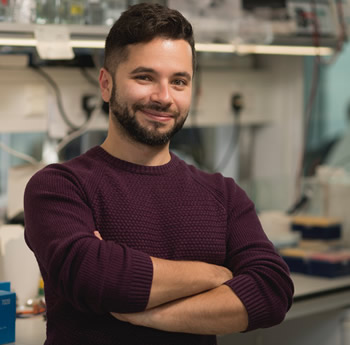Dr. Sebastian FicaBy Mariela Cortés-López  Dr. Sebastian Fica is a Wellcome Trust and Sir Henry Dale Fellow at the Department of Biochemistry at the University of Oxford where he studies pre-mRNA splicing. His lab opened in August 2021 and uses biochemical and structural approaches to understand the structural dynamics of the spliceosome and 3’ splice site selection during the catalytic stage of splicing. He developed this line of research during the final stage of his postdoctoral fellowship in the group of Dr. Kiyoshi Nagai at the MRC’s Laboratory of Molecular Biology in Cambridge, UK. While there, he solved some of the first structures of the yeast and human spliceosome and, together with his colleagues, identified novel human splicing factors. Dr. Fica obtained his Bachelor’s degree in Molecular Biology and Government at Skidmore College in upstate New York. During his undergraduate biology classes his interest in RNA world was fuelled by the enthusiastic lectures of Professor Patricia Hilleren, who emphasized the central role of RNA in life. Inspired by his course experience, Dr. Fica began his research career working for the summer in Prof. Hilleren’s lab. His next step took him to the University of Chicago, where he earned a PhD under the guidance of Professors Jonathan Staley and Joseph Piccirilli. Shortly after he began his thesis research, he was hooked by the combination of chemistry and biology implied in the process of RNA-based catalysis. From Chicago, he moved to Cambridge, UK in 2014 to do a postdoc at the lab of Professor Kiyoshi Nagai to work on the structures of active spliceosomes. Dr. Fica then opened his independent lab at the University of Oxford during the height of the COVID-19 pandemic. He noted that it is an especially challenging time to be a young group leader. Despite postponing the opening of his lab, shipping delays and shortages and limited opportunities to network in person continue to present obstacles for building his young group. Like many of us, he is looking forward to again having crucial face-to-face interactions with other scientists. Beyond receiving excellent scientific training from his mentors, Dr. Fica also stresses the importance of having worked with emotionally supportive advisors. “Struggles are natural,” Dr. Fica says, as he credits the ability of his mentors to help him navigate trying times as being instrumental to his success. He will always remember how Dr. Nagai allowed him to “heal at his own mental pace” after a moment of personal loss, and Professor Staley inspired him to persevere during a challenging period when he was considering abandoning his graduate studies. He emphasized the importance of knowing when to ask for help. Dr. Fica is committed to supporting his students as his mentors encouraged him. As he has begun his independent career, he tries to keep in mind that “it is important to share the burden of doing research, but also the excitement of discovery.” Dr. Fica recommends that RNA researchers focus on doing the best experiment they can without worrying about competition, always using imagination, and dreaming big: “If you believe in that spark of an idea, you shouldn’t let others dissuade you from following your insight and imagination, even when those others may appear as they know more about the problem you’re trying to address.” Dr. Fica loves to work in the lab and hopes to never stop running gels. He enjoys the thrill of experiencing discoveries before anyone else knows, like the magic moment when he first saw RNA helices in the 3D map of an active spliceosome. Science has given him the freedom for creativity and playfulness, features that would have been more difficult to experience if he had chosen the path of becoming a surgeon, which was also fascinating for him at a young age. The RNA society has allowed Dr. Fica to engage with the RNA community and facilitated finding information about meetings and colleagues with similar interests. He appreciates the recent initiatives targeted for junior scientists and wishes they would have existed more during his years as a newcomer to the field. Dr. Fica’s favourite RNA is U6, as it catalyzes splicing. You can learn more about Dr. Fica’s research on Twitter @Seb_Fica or on his website (https://snrnpsplicingbiochemlab.web.ox.ac.uk/). He would be happy to hear from potential postdocs interested in the world of RNA! |
